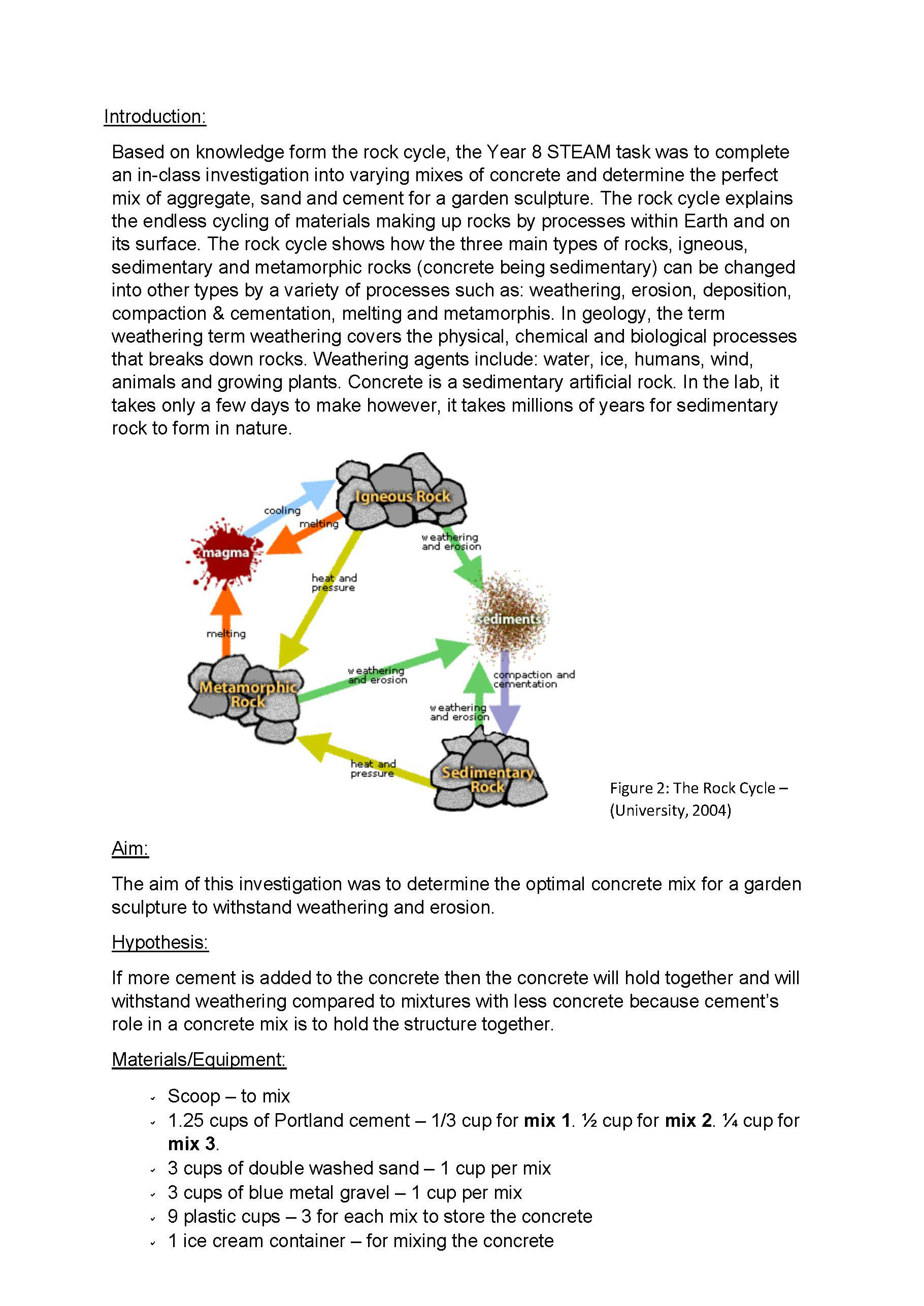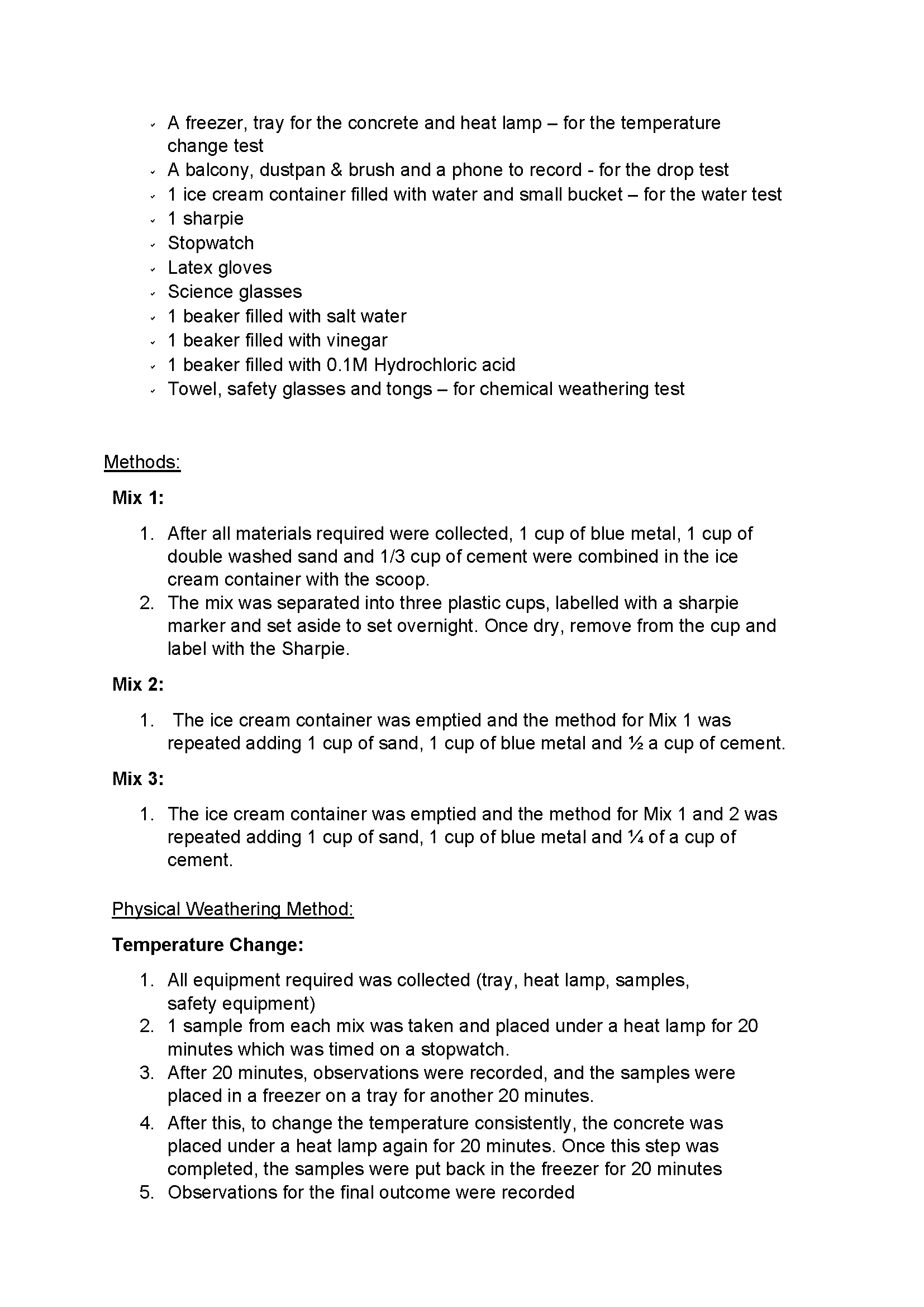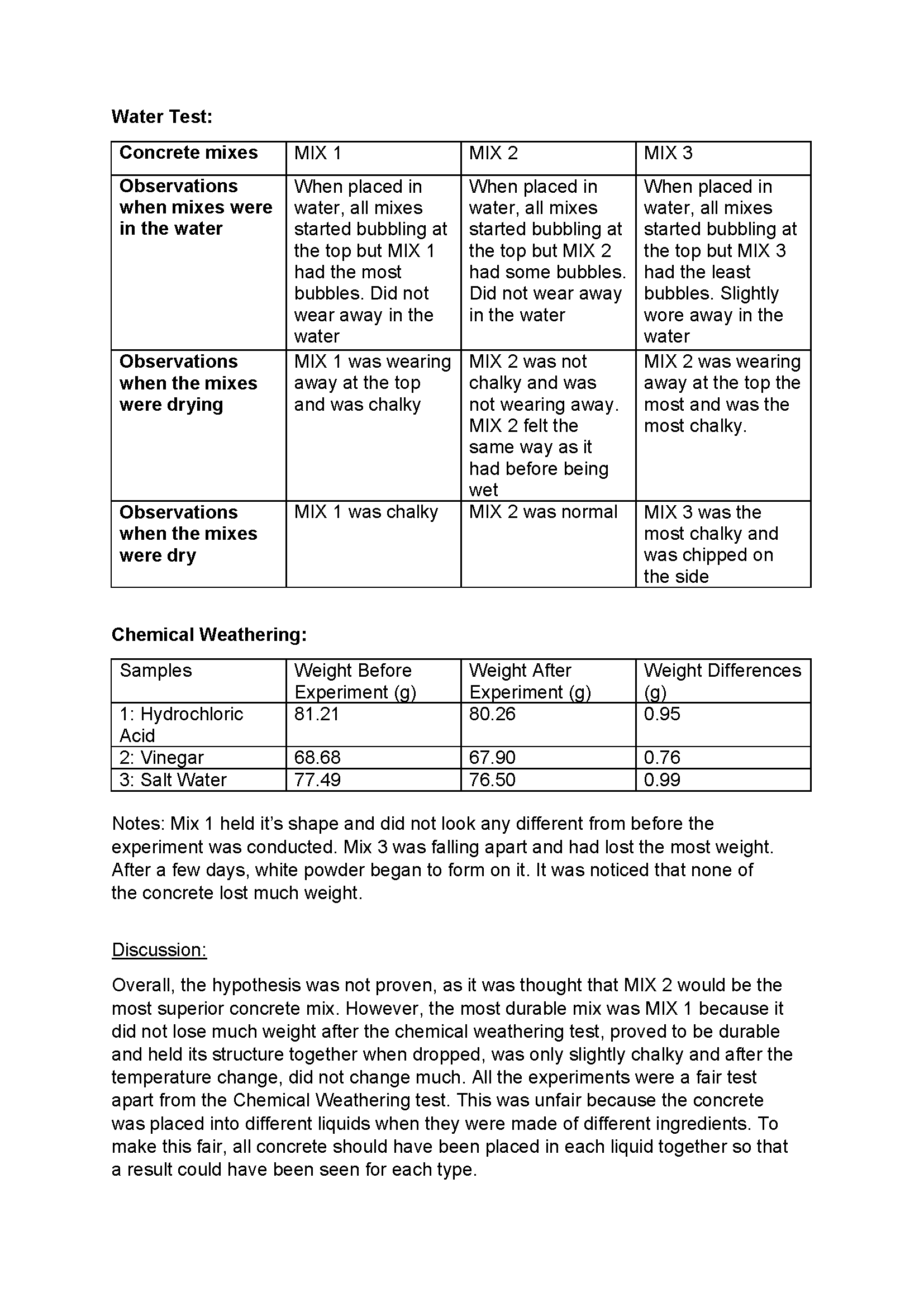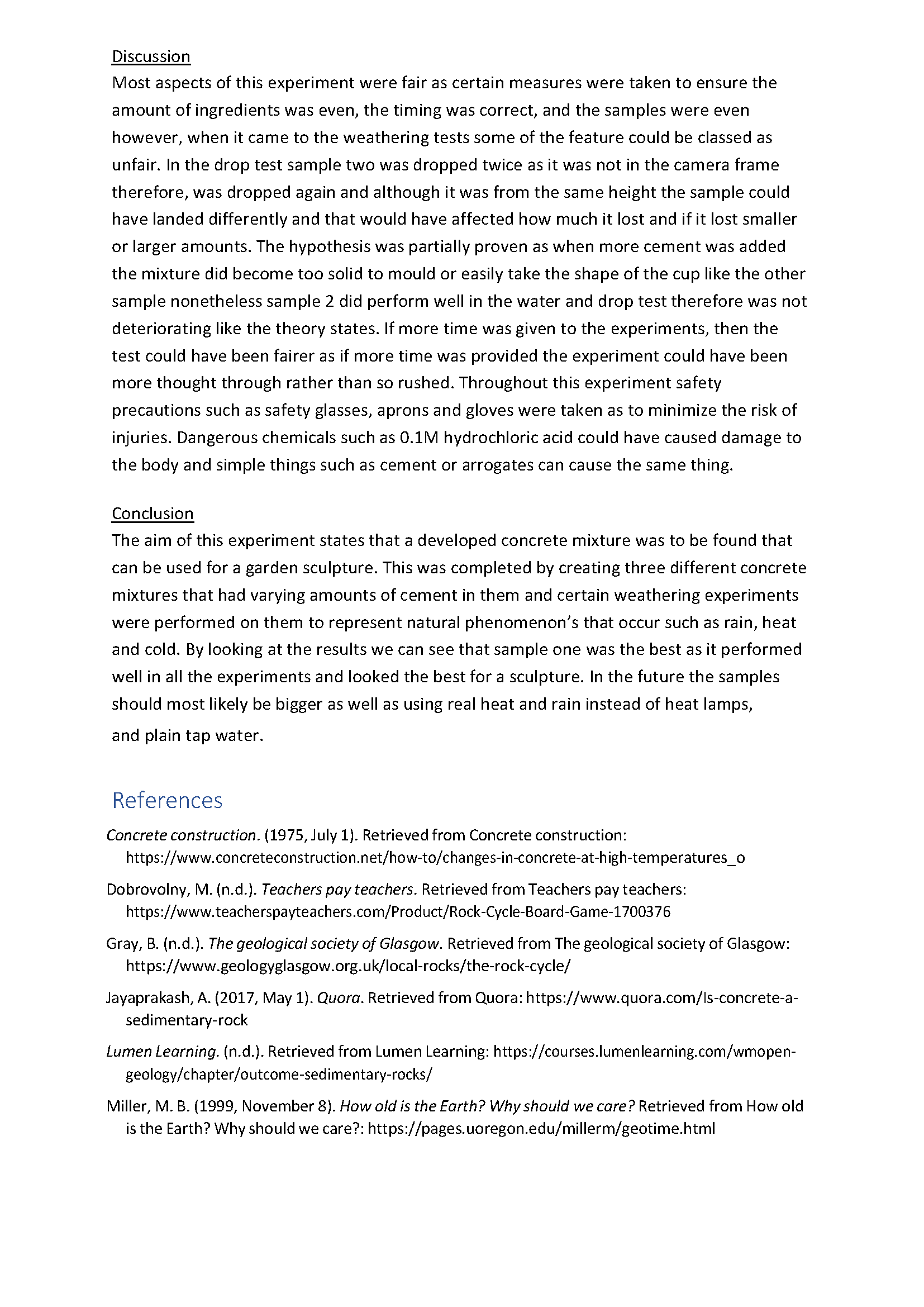- Home
- Resources
- Work samples
- Samples
- Concrete sculpture – ABOVE
Science
Year 8
Above satisfactory
Concrete sculpture
 1
Annotation 1
1
Annotation 1
Defines aspects of rock cycle that are relevant to investigation 2 Annotation 2
Identifies timescales as main difference between natural rock cycle and processed materials used in investigation 3 Annotation 3
Uses diagram to describe rock cycle 4 Annotation 4
States clear aim and purpose of investigation 5 Annotation 5
Uses scientific reasoning and valid inference to support hypothesis
-
Annotations
-
1
Annotation 1
Defines aspects of rock cycle that are relevant to investigation -
2
Annotation 2
Identifies timescales as main difference between natural rock cycle and processed materials used in investigation -
3
Annotation 3
Uses diagram to describe rock cycle -
4
Annotation 4
States clear aim and purpose of investigation -
5
Annotation 5
Uses scientific reasoning and valid inference to support hypothesis
 1
Annotation 1
1
Annotation 1
Describes experimental methods in clearly structured layout using appropriate headings
-
Annotations
-
1
Annotation 1
Describes experimental methods in clearly structured layout using appropriate headings
 1
Annotation 1
1
Annotation 1
Describes test results supported by detailed observations 2 Annotation 2
Provides detailed observations
-
Annotations
-
1
Annotation 1
Describes test results supported by detailed observations -
2
Annotation 2
Provides detailed observations
 1
Annotation 1
1
Annotation 1
Presents results in clearly structured layout using appropriate headings and well-organised tables 2 Annotation 2
Describes individual results systematically using precise and consistent wording 3 Annotation 3
Provides additional relevant information and summarises outcome of individual tests 4 Annotation 4
Explains in detail how results contradict hypothesis
-
Annotations
-
1
Annotation 1
Presents results in clearly structured layout using appropriate headings and well-organised tables -
2
Annotation 2
Describes individual results systematically using precise and consistent wording -
3
Annotation 3
Provides additional relevant information and summarises outcome of individual tests -
4
Annotation 4
Explains in detail how results contradict hypothesis
 1
Annotation 1
1
Annotation 1
Summarises results and concludes that they do not support hypothesis 2 Annotation 2
Uses evidence from each test result to justify selection of optimal mixture 3 Annotation 3
Explains how one test was unfair and suggests viable improvement to method
-
Annotations
-
1
Annotation 1
Summarises results and concludes that they do not support hypothesis -
2
Annotation 2
Uses evidence from each test result to justify selection of optimal mixture -
3
Annotation 3
Explains how one test was unfair and suggests viable improvement to method
 1
Annotation 1
1
Annotation 1
Identifies and classifies variables as independent, dependent and controlled 2 Annotation 2
Restates aim and concisely summarises how investigation was conducted 3 Annotation 3
Restates which mixture was found to be optimal 4 Annotation 4
Reiterates how hypothesis was not supported 5 Annotation 5
Suggests improvements to experimental method for future investigations 6 Annotation 6
Provides list of resources used to research topic of investigation
-
Annotations
-
1
Annotation 1
Identifies and classifies variables as independent, dependent and controlled -
2
Annotation 2
Restates aim and concisely summarises how investigation was conducted -
3
Annotation 3
Restates which mixture was found to be optimal -
4
Annotation 4
Reiterates how hypothesis was not supported -
5
Annotation 5
Suggests improvements to experimental method for future investigations -
6
Annotation 6
Provides list of resources used to research topic of investigation
Satisfactory
Concrete sculpture
 1
Annotation 1
1
Annotation 1
Defines 'concrete' and explains how it is similar to natural rocks 2 Annotation 2
Describes rock cycle, refers to diagram and timescales 3 Annotation 3
Includes aim of investigation and details of experimental design 4 Annotation 4
Uses scientific reasoning to support hypothesis
-
Annotations
-
1
Annotation 1
Defines 'concrete' and explains how it is similar to natural rocks -
2
Annotation 2
Describes rock cycle, refers to diagram and timescales -
3
Annotation 3
Includes aim of investigation and details of experimental design -
4
Annotation 4
Uses scientific reasoning to support hypothesis
 1
Annotation 1
1
Annotation 1
Describes experimental methods in detail
-
Annotations
-
1
Annotation 1
Describes experimental methods in detail
 1
Annotation 1
1
Annotation 1
Describes test results supported by detailed observations 2 Annotation 2
Presents numerical results in table
-
Annotations
-
1
Annotation 1
Describes test results supported by detailed observations -
2
Annotation 2
Presents numerical results in table
 1
Annotation 1
1
Annotation 1
Explains how one of the tests was unfair 2 Annotation 2
Explains how results support only certain aspects of hypothesis 3 Annotation 3
Describes safety precautions 4 Annotation 4
Restates aim and summarises how investigation was conducted 5 Annotation 5
Identifies optimal mixture 6 Annotation 6
Suggests improvements to experimental method for future investigations 7 Annotation 7
Provides list of resources used to research topic of investigation
-
Annotations
-
1
Annotation 1
Explains how one of the tests was unfair -
2
Annotation 2
Explains how results support only certain aspects of hypothesis -
3
Annotation 3
Describes safety precautions -
4
Annotation 4
Restates aim and summarises how investigation was conducted -
5
Annotation 5
Identifies optimal mixture -
6
Annotation 6
Suggests improvements to experimental method for future investigations -
7
Annotation 7
Provides list of resources used to research topic of investigation
Above satisfactory
Concrete sculpture
 1
Annotation 1
1
Annotation 1
Defines aspects of rock cycle that are relevant to investigation 2 Annotation 2
Identifies timescales as main difference between natural rock cycle and processed materials used in investigation 3 Annotation 3
Uses diagram to describe rock cycle 4 Annotation 4
States clear aim and purpose of investigation 5 Annotation 5
Uses scientific reasoning and valid inference to support hypothesis
-
Annotations
-
1
Annotation 1
Defines aspects of rock cycle that are relevant to investigation -
2
Annotation 2
Identifies timescales as main difference between natural rock cycle and processed materials used in investigation -
3
Annotation 3
Uses diagram to describe rock cycle -
4
Annotation 4
States clear aim and purpose of investigation -
5
Annotation 5
Uses scientific reasoning and valid inference to support hypothesis
 1
Annotation 1
1
Annotation 1
Describes experimental methods in clearly structured layout using appropriate headings
-
Annotations
-
1
Annotation 1
Describes experimental methods in clearly structured layout using appropriate headings
 1
Annotation 1
1
Annotation 1
Describes test results supported by detailed observations 2 Annotation 2
Provides detailed observations
-
Annotations
-
1
Annotation 1
Describes test results supported by detailed observations -
2
Annotation 2
Provides detailed observations
 1
Annotation 1
1
Annotation 1
Presents results in clearly structured layout using appropriate headings and well-organised tables 2 Annotation 2
Describes individual results systematically using precise and consistent wording 3 Annotation 3
Provides additional relevant information and summarises outcome of individual tests 4 Annotation 4
Explains in detail how results contradict hypothesis
-
Annotations
-
1
Annotation 1
Presents results in clearly structured layout using appropriate headings and well-organised tables -
2
Annotation 2
Describes individual results systematically using precise and consistent wording -
3
Annotation 3
Provides additional relevant information and summarises outcome of individual tests -
4
Annotation 4
Explains in detail how results contradict hypothesis
 1
Annotation 1
1
Annotation 1
Summarises results and concludes that they do not support hypothesis 2 Annotation 2
Uses evidence from each test result to justify selection of optimal mixture 3 Annotation 3
Explains how one test was unfair and suggests viable improvement to method
-
Annotations
-
1
Annotation 1
Summarises results and concludes that they do not support hypothesis -
2
Annotation 2
Uses evidence from each test result to justify selection of optimal mixture -
3
Annotation 3
Explains how one test was unfair and suggests viable improvement to method
 1
Annotation 1
1
Annotation 1
Identifies and classifies variables as independent, dependent and controlled 2 Annotation 2
Restates aim and concisely summarises how investigation was conducted 3 Annotation 3
Restates which mixture was found to be optimal 4 Annotation 4
Reiterates how hypothesis was not supported 5 Annotation 5
Suggests improvements to experimental method for future investigations 6 Annotation 6
Provides list of resources used to research topic of investigation
-
Annotations
-
1
Annotation 1
Identifies and classifies variables as independent, dependent and controlled -
2
Annotation 2
Restates aim and concisely summarises how investigation was conducted -
3
Annotation 3
Restates which mixture was found to be optimal -
4
Annotation 4
Reiterates how hypothesis was not supported -
5
Annotation 5
Suggests improvements to experimental method for future investigations -
6
Annotation 6
Provides list of resources used to research topic of investigation